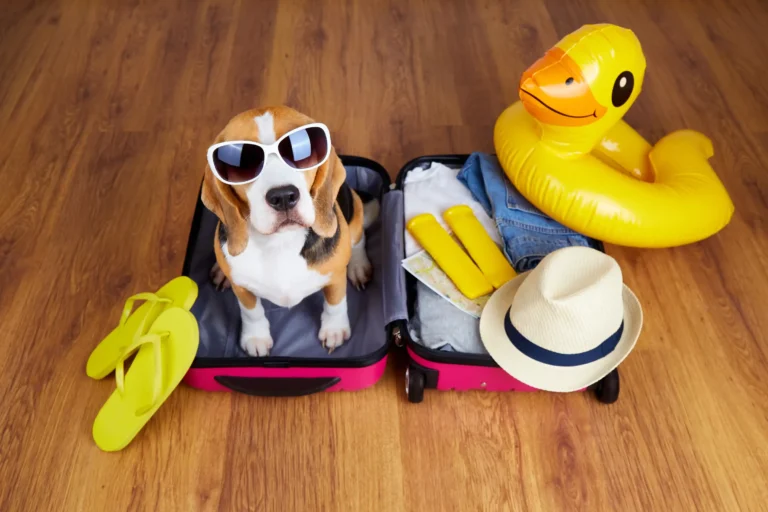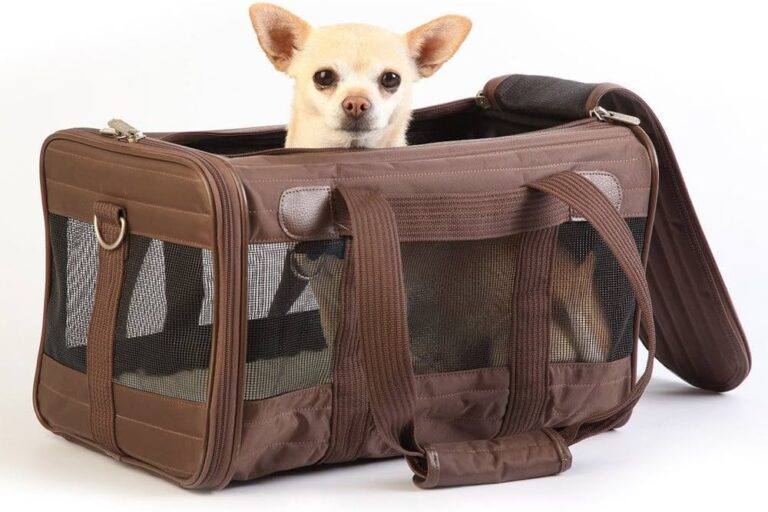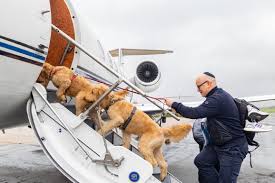Flying with a small dog can seem daunting for many pet parents. However, with the right knowledge and preparation, taking to the skies with your four-legged friend can become an exciting adventure rather than a nerve-racking ordeal. In the following guide, the aim is to provide comprehensive advice and insights for small dog owners embarking on their first flight journey. Buckle up and get ready for a smooth take-off into a world of new experiences and memories with your loyal companion.
The discussion commences with an overview of the essential pre-flight preparations. This includes choosing the right airline, understanding pet policies, and gathering the necessary documentation for your furry friend. In addition, health checks, training, and pet-friendly travel gear are explored to ensure your dog is physically and mentally prepared for the journey ahead.
The second part of the guide delves into the details of the journey itself. From arrival at the airport to in-flight care, these insights will help ensure a comfortable and stress-free experience for both you and your dog. The content also addresses common concerns such as pet relief areas, noise, and turbulence.
Moving on, the guide provides practical tips on how to help your dog adjust to the new environment upon landing. This includes dealing with jet lag, new climates, and unfamiliar surroundings. The importance of patience, understanding, and consistency in maintaining your dog’s routine is emphasized.
In conclusion, the guide will present a series of real-life experiences and anecdotes from seasoned pet travelers. Their wisdom and experiences offer valuable lessons and tips that can help make the first flight with your small dog a delightful and memorable experience. Fasten your seatbelts and get ready to explore new horizons with your beloved pet.
Understanding Air Travel Regulations for Small Dogs
Air travel can be quite intimidating for first-time flyers, and it can be even more daunting when you are planning to take your small dog along with you. Therefore, before embarking on this new adventure, it’s crucial to familiarize yourself with the regulations and requirements of air travel for pets.
Firstly, it’s important to know that not all airlines allow pets on board. The airlines that do allow pets, have specific rules and regulations that must be adhered to. These regulations may vary by airline, but generally include things like maximum weight limits, carrier specifications, and health requirements.
Airline Policies and Procedures
Different airlines have different pet policies. Some airlines allow small dogs to travel in the cabin with their owners, while others may require pets to be transported in the cargo hold. It’s imperative to check with your airline well in advance about their pet policies. This information can usually be found on the airline’s website or by contacting their customer service department.

Health Requirements
Most airlines require a health certificate from a licensed veterinarian confirming that your pet is fit to fly. This certificate usually needs to be issued within a certain time frame before travel – typically 10 days. Some airlines may also require proof of certain vaccinations.
Preparing Your Dog for the Flight
Preparing your dog for air travel is no less important than understanding the rules and regulations. Your pet’s comfort and safety should be your primary concern.

Choose an Appropriate Carrier
Selecting the right carrier is crucial for your dog’s comfort. It must be well-ventilated, secure, and big enough for your pet to stand, turn around, and lie down comfortably. Many airlines have specific carrier requirements, so make sure you comply with these.
Acclimate Your Dog to the Carrier
Before the flight, it’s essential to get your dog used to the carrier. Let them spend time in it at home, turning it into a comfortable and familiar space. This will help reduce their anxiety during the flight.
On the Day of the Flight
Preparing properly on the day of the flight is just as important as the work you have done beforehand. A smooth experience at the airport sets the tone for the entire journey, ensuring that both you and your small dog travel with minimal stress and maximum comfort.
Packing Essentials
Ensure that you have a dedicated bag for your dog’s travel essentials. In your carry-on luggage, you should pack a leash, a collapsible water bowl, a small supply of food or treats, any necessary medications, wet wipes, waste bags, a soft blanket, and a favorite toy to provide comfort. These items will help you attend to your dog’s needs quickly and efficiently during the trip. It is also wise to carry an extra copy of your dog’s health certificate and vaccination records in case they are requested at any point.
Feeding and Exercise
Feeding your dog properly before the flight is critical. A light meal three to four hours prior to departure is recommended to avoid nausea or discomfort during travel. Heavy meals too close to flight time can increase the risk of motion sickness. Additionally, make sure your dog has plenty of exercise before heading to the airport. A long walk or play session can help expend some of their energy, making them more relaxed and likely to rest during the flight.
Navigating Airport Security with Your Dog
At security checkpoints, you will usually be asked to remove your dog from its carrier and carry them through the metal detector while the carrier is screened separately. Practice this procedure ahead of time if possible. Make sure your dog is wearing a secure harness or collar and a leash at all times to prevent any unexpected escapes in the busy airport environment.
Managing Pre-Boarding and Waiting Areas
Once you have cleared security, locate the nearest pet relief area so your dog can relieve themselves before boarding. Airports are increasingly offering designated pet relief zones to accommodate traveling animals. While waiting for your flight, keep your dog in the carrier unless you are at a pet-friendly area where it is allowed to be out on a leash. Provide water to keep your pup hydrated but avoid giving too much food to prevent mid-flight discomfort.
Boarding and Settling In
When it is time to board the plane, try to be one of the last to enter. This reduces the time your dog will have to spend confined in the carrier under the seat. Once seated, place the carrier securely under the seat in front of you. Speak calmly to your dog to reassure them and avoid unnecessary movement of the carrier during the flight.
In-Flight Tips for a Comfortable Experience
During the flight, keep your dog as calm as possible. Avoid opening the carrier unless absolutely necessary. Softly speaking to your dog, providing a familiar toy, or lightly stroking the carrier can all help to comfort them. If your dog seems particularly anxious, remain calm yourself, as dogs are highly attuned to the emotions of their owners.
Post-Flight Care for Small Dogs
After a successful flight, your attention should immediately shift to helping your dog readjust and recover from the travel experience.
Hydration and Food
Upon landing and retrieving your belongings, find a quiet spot where your dog can safely stretch and rehydrate. Offer them water first, then a small meal if it has been a while since their last feeding. Avoid feeding large amounts right away, as their digestive system might still be unsettled from the travel.
Give Your Dog Time to Adjust
Entering a new environment can be overwhelming for your dog, especially after the stress of flying. Allow them to acclimate at their own pace. Stick to familiar routines such as feeding times, walks, and bedtime rituals to create a sense of normalcy. Keep initial outings short and relaxed until your dog seems more confident and comfortable in the new surroundings.
Monitoring Your Dog’s Health Post-Flight
Monitor your dog closely in the hours and days after the flight for any signs of illness, stress, or dehydration. Common signs of post-travel stress in dogs include lethargy, refusal to eat, vomiting, diarrhea, or excessive panting. If any symptoms persist, consult a local veterinarian immediately. A post-flight check-up can be a wise precaution, especially after long international flights.
Considerations for International Travel
When your journey involves crossing international borders, additional steps must be taken to ensure your pet’s smooth and legal entry into a foreign country.
Research Destination Requirements
Different countries have varying requirements regarding pet importation. Some nations require quarantine upon arrival, others may mandate specific vaccinations, and many require advanced registration with customs or agricultural departments. Thoroughly research your destination’s regulations well in advance and begin necessary paperwork or vaccinations according to their timelines.
Additional Documentation
For international travel, you will likely need more than just a health certificate. Depending on the destination, you might need an import permit, microchip registration, rabies antibody titer test results, and evidence of deworming treatment. All documents should be carried in both physical and digital copies to prevent issues if originals are misplaced.
Booking Flights with International Requirements in Mind
When booking flights for international travel, prioritize airlines that have robust pet travel programs and experience with international pet transport. They can guide you through the additional requirements and often offer assistance with customs clearance and delivery services if needed.
Quarantine Considerations
If your destination mandates quarantine, familiarize yourself with the quarantine facility, policies, and procedures. Understand the duration, visitation rules, and care conditions offered. Knowing your dog will be well looked after will ease the emotional burden of the temporary separation.
Preparing for Cultural Differences
Be aware that attitudes toward pets can differ significantly around the world. Some cultures warmly embrace dogs in public spaces, while others may restrict them from parks, restaurants, and other communal areas. Understanding these cultural nuances will help you plan activities that both you and your dog can enjoy safely.
Conclusion to Preparations
Successful air travel with a small dog demands planning, patience, and a keen understanding of regulations and your dog’s personal needs. By addressing every detail from the moment you book your flight to your arrival at the final destination, you pave the way for a truly rewarding experience. Each trip builds your dog’s travel confidence, creating wonderful opportunities for future adventures together. With the right preparation, you and your small pup can conquer the skies and embrace the many wonders of the world, one flight at a time.
Conclusion
In wrapping up, “The Sky’s the Limit: A Guide for Small Dog Owners on Their First Flight Adventure” provides invaluable advice for new pet owners looking to embark on air travel with their furry companions. This guide not only demystifies the process but also provides actionable tips and guidelines to ensure a smooth and enjoyable journey for both the pet and its owner.
From pre-flight preparations to navigating through airport procedures, the guide covers a comprehensive range of topics, thus creating a roadmap to successful air travel with small dogs. The importance of familiarizing your pet with their travel carrier, choosing pet-friendly airlines, and understanding the specific travel requirements can’t be overstated.
This guide makes it clear that with the right preparation and attitude, the sky truly is the limit for small dog owners wanting to explore the world with their pets. It encourages owners to see air travel not as a daunting task but as an exciting adventure that can be comfortably undertaken with their pets. To sum up, the first flight adventure with your small dog doesn’t have to be overwhelming or scary; with the right guidance, it can be a thrilling start to many more journeys to come.
Building Confidence for Future Travels
Experiencing a successful first flight with your small dog is just the beginning. Each trip builds not only your confidence as a traveling pet owner but also strengthens your dog’s adaptability and resilience. Future trips become progressively easier as your dog becomes more familiar with the sights, sounds, and routines associated with air travel. Practicing good habits from the start will create a positive foundation that encourages stress-free travels for years to come.
Strengthening the Bond Between You and Your Pet
Traveling together strengthens the emotional bond between you and your dog. Navigating new environments, overcoming small challenges, and sharing new experiences deepen the trust and communication between you. Dogs are incredibly intuitive and will look to their owners for reassurance in unfamiliar situations. The comfort and security you provide during travel moments will translate into a stronger relationship overall.
Continuing Your Dog’s Socialization and Adaptability
Exposure to new people, places, and situations is essential for maintaining a well-rounded and socialized dog. Travel exposes your pup to a variety of stimuli, which can help reduce fear and anxiety in everyday life. Airports, planes, and foreign destinations provide valuable opportunities for your small dog to practice calm behavior, patience, and adaptability. These skills will be useful not just during travel but in many other aspects of life as well.
Investing in the Right Gear for Frequent Flyers
If you and your dog plan to become frequent flyers, investing in high-quality travel gear is a wise decision. Durable, airline-compliant carriers, comfortable travel harnesses, and lightweight collapsible bowls can make a significant difference in your travel experience. Some pet owners even consider noise-canceling earmuffs designed for dogs, which can help sensitive pups remain calm during takeoff and landing. Travel gear specifically designed for pets can enhance both safety and comfort, making your journeys even more enjoyable.
Embracing Flexibility and Patience
No two travel experiences are identical, and unexpected situations can arise despite careful planning. Flight delays, changes in regulations, or unfamiliar environments can challenge even the most seasoned travelers. Approaching each travel day with flexibility and patience is key. Your dog will take emotional cues from you, and maintaining a calm, positive attitude will help them adjust to any bumps along the way.



